lock MITSUBISHI LANCER EVOLUTION 2014 10.G Owners Manual
[x] Cancel search | Manufacturer: MITSUBISHI, Model Year: 2014, Model line: LANCER EVOLUTION, Model: MITSUBISHI LANCER EVOLUTION 2014 10.GPages: 338, PDF Size: 40.99 MB
Page 3 of 338
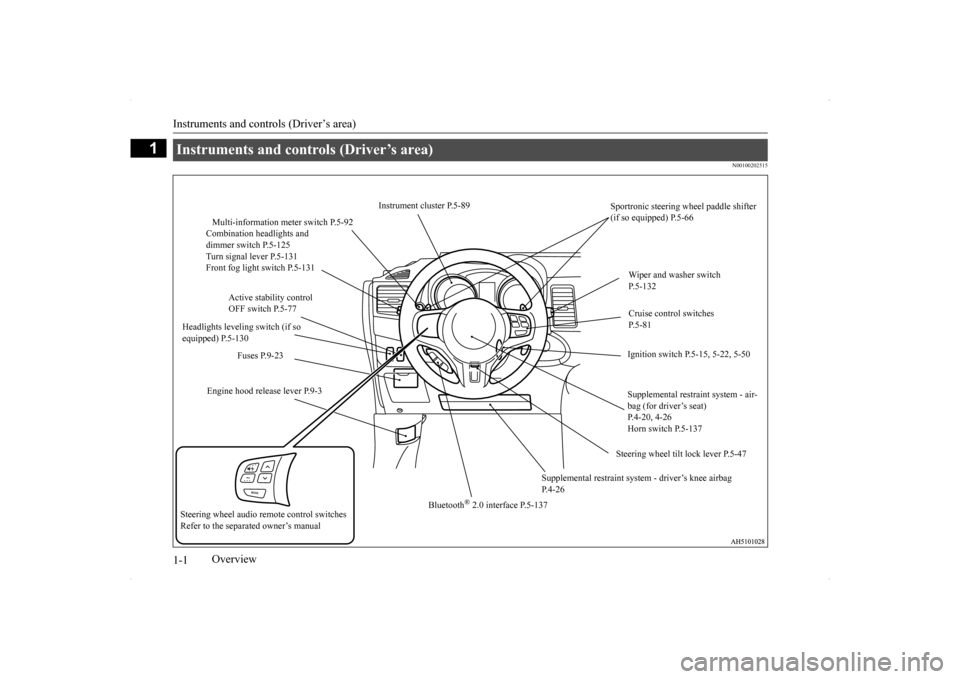
Instruments and controls (Driver’s area) 1-1
1
Overview
N00100202515
Instruments and controls (Driver’s area)
Instrument cluster P.5-89
Sportronic steering wheel paddle shifter (if so equipped) P.5-66
Multi-information meter switch P.5-92 Combination headlights and dimmer switch P.5-125Turn signal lever P.5-131 Front fog light switch P.5-131
Wiper and washer switch P.5-132
Active stability control OFF switch P.5-77
Cruise control switches P. 5 - 8 1
Headlights leveling switch (if so equipped) P.5-130
Ignition switch P.5-15, 5-22, 5-50
Fuses P.9-23
Engine hood release lever P.9-3
Supplemental restraint system - air- bag (for driver’s seat) P.4-20, 4-26Horn switch P.5-137
Steering wheel tilt lock lever P.5-47
Supplemental restraint system
- driver’s knee airbag
P.4-26
Bluetooth
® 2.0 interface P.5-137
Steering wheel audio remote control switches Refer to the separa
ted owner’s manual
BK0200800US.bo
ok 1 ページ 2013年2月14日 木曜日 午後2時28分
Page 6 of 338
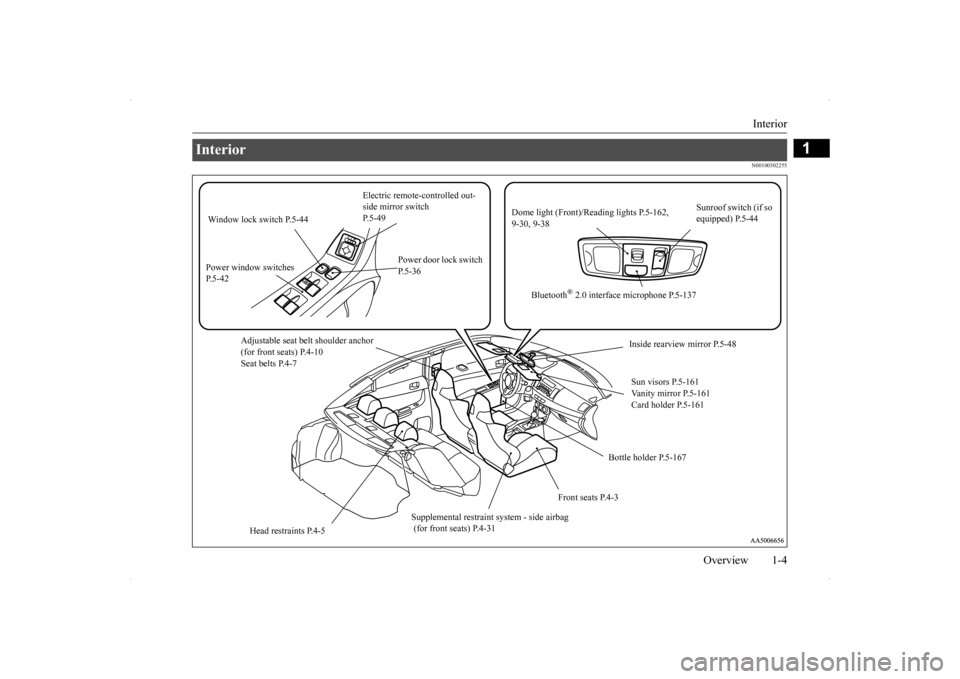
Interior
Overview 1-4
1
N00100302255
Interior
Electric remote-controlled out- side mirror switch P.5-49
Sunroof switch (if so equipped) P.5-44
Dome light (Front)/R
eading lights P.5-162,
9-30, 9-38
Window lock switch P.5-44 Power window switches P.5-42
Power door lock switch P.5-36
Bluetooth
® 2.0 interface microphone P.5-137
Adjustable seat belt shoulder anchor (for front seats) P.4-10 Seat belts P.4-7
Inside rearview mirror P.5-48 Sun visors P.5-161 Vanity mirror P.5-161Card holder P.5-161
Bottle holder P.5-167
Front seats P.4-3
Supplemental restraint
system - side airbag
(for front seats) P.4-31
Head restraints P.4-5
BK0200800US.bo
ok 4 ページ 2013年2月14日 木曜日 午後2時28分
Page 9 of 338
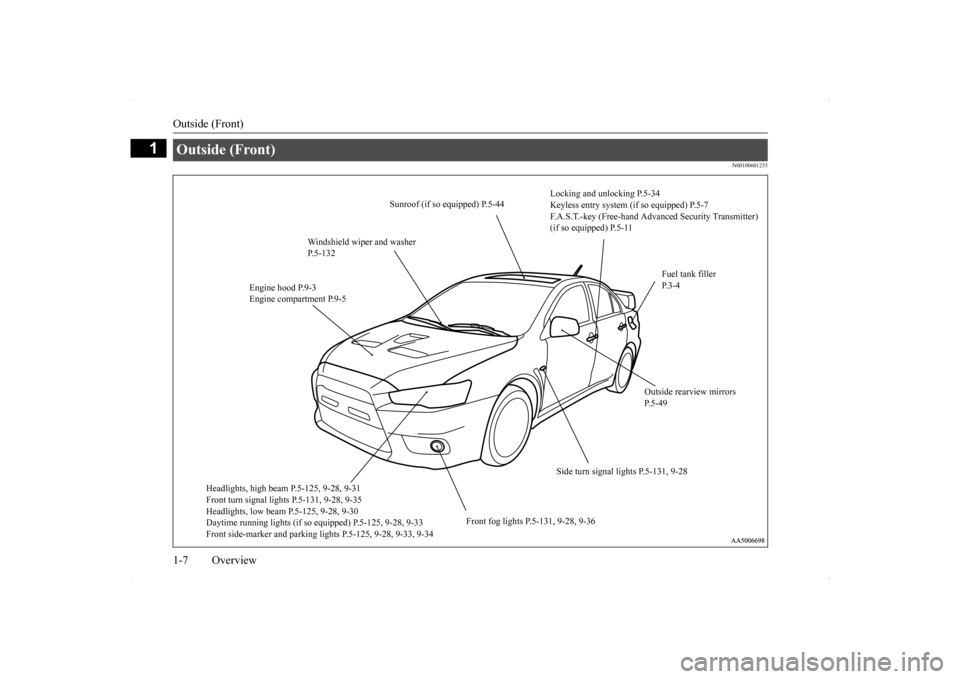
Outside (Front) 1-7 Overview
1
N00100601235
Outside (Front)
Locking and unlocking P.5-34 Keyless entry system (if so equipped) P.5-7F.A.S.T.-key (Free-hand Advanced Security Transmitter) (if so equipped) P.5-11
Sunroof (if so equipped) P.5-44
Windshield wiper and washer P.5-132
Fuel tank filler P.3-4
Engine hood P.9-3 Engine compartment P.9-5
Outside rearview mirrors P.5-49
Side turn signal
lights P.5-131, 9-28
Headlights, high beam
P.5-125, 9-28, 9-31
Front turn signal light
s P.5-131, 9-28, 9-35
Headlights, low beam P.5-125, 9-28, 9-30Daytime running lights (if so
equipped) P.5-125, 9-28, 9-33
Front side-marker and parking lig
hts P.5-125, 9-28, 9-33, 9-34
Front fog lights P.5-131, 9-28, 9-36
BK0200800US.bo
ok 7 ページ 2013年2月14日 木曜日 午後2時28分
Page 13 of 338
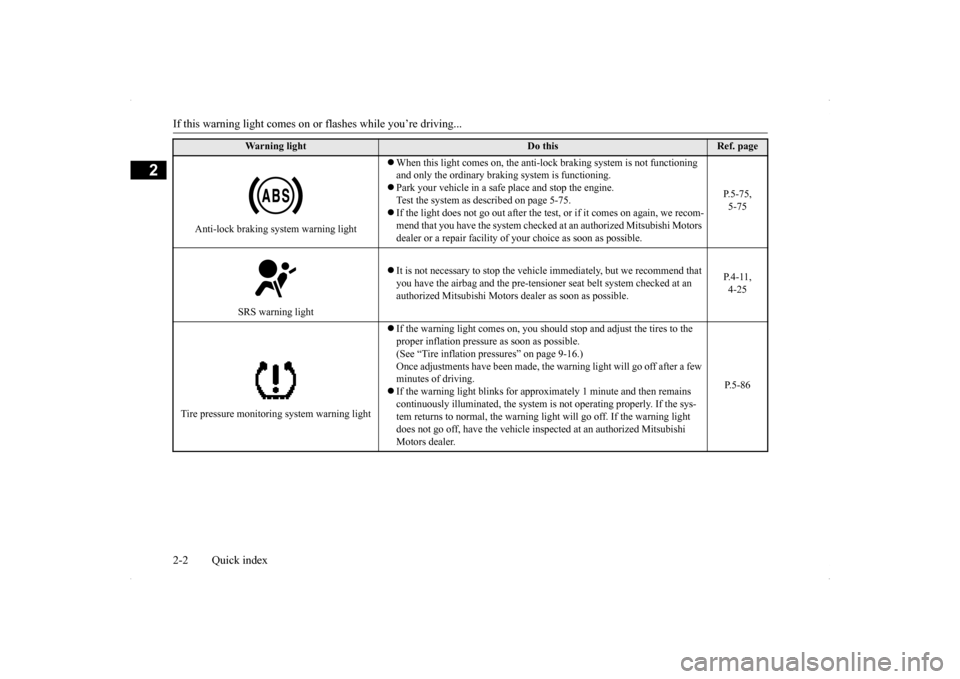
If this warning light comes on or
flashes while you’re driving...
2-2 Quick index
2
Anti-lock braking system warning light
When this light comes on, the anti-lock braking system is not functioning and only the ordinary braking system is functioning. Park your vehicle in a safe
place and stop the engine.
Test the system as described on page 5-75. If the light does not go out after the test
, or if it comes on again, we recom-
mend that you have the system checked at
an authorized Mitsubishi Motors
dealer or a repair facility of your choice as soon as possible.
P.5-75, 5-75
SRS warning light
It is not necessary to stop the vehicl
e immediately, but we recommend that
you have the airbag and the pre-tensione
r seat belt system checked at an
authorized Mitsubishi Motors dealer as soon as possible.
P.4-11, 4-25
Tire pressure monitoring system warning light
If the warning light comes on, you should
stop and adjust the tires to the
proper inflation pressure as soon as possible. (See “Tire inflation pressures” on page 9-16.)Once adjustments have been made, the
warning light will go off after a few
minutes of driving. If the warning light blinks for approximately 1 minute and then remains continuously illuminated, the system is not operating properly. If the sys- tem returns to normal, the warning light will go off. If the warning light does not go off, have the vehicle inspected at an authorized Mitsubishi Motors dealer.
P.5-86
Warning light
Do this
Ref. page
BK0200800US.bo
ok 2 ページ 2013年2月14日 木曜日 午後2時28分
Page 14 of 338
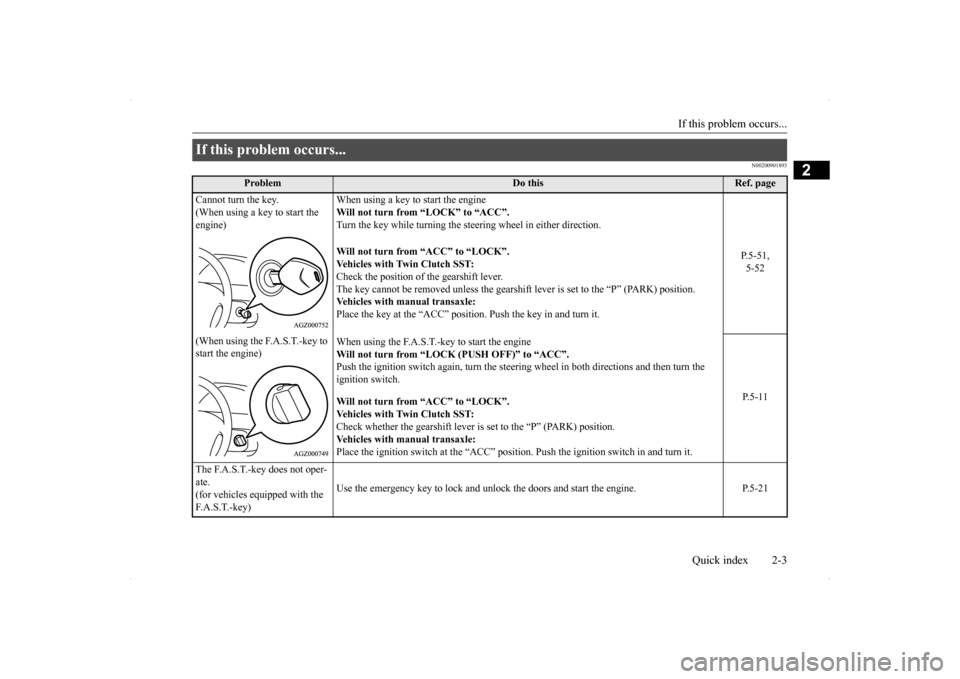
If this problem occurs...
Quick index 2-3
2
N00200901893
If this problem occurs...
Problem
Do this
Ref. page
Cannot turn the key. (When using a key to start the engine)
When using a key to start the engine Will not turn from “LOCK” to “ACC”. Turn the key while turning the steering wheel in either direction.
P.5-51, 5-52
Will not turn from “ACC” to “LOCK”. Vehicles with Twin Clutch SST: Check the position of the gearshift lever.The key cannot be removed unless the gearshif
t lever is set to the “P” (PARK) position.
Vehicles with manual transaxle: Place the key at the “ACC” position. Push the key in and turn it.
(When using the F.A.S.T.-key to start the engine)
When using the F.A.S.T.-key to start the engine Will not turn from “LOCK (PUSH OFF)” to “ACC”.Push the ignition switch again, turn the steering
wheel in both directions and then turn the
ignition switch. Will not turn from “ACC” to “LOCK”. Vehicles with Twin Clutch SST:Check whether the gearshift lever is set to the “P” (PARK) position. Vehicles with manual transaxle: Place the ignition switch at the “ACC” position.
Push the ignition switch in and turn it.
P. 5 - 1 1
The F.A.S.T.-key does not oper- ate. (for vehicles equipped with the F. A . S . T. - k e y )
Use the emergency key to lock and unlock the doors and start the engine. P.5-21
BK0200800US.bo
ok 3 ページ 2013年2月14日 木曜日 午後2時28分
Page 21 of 338
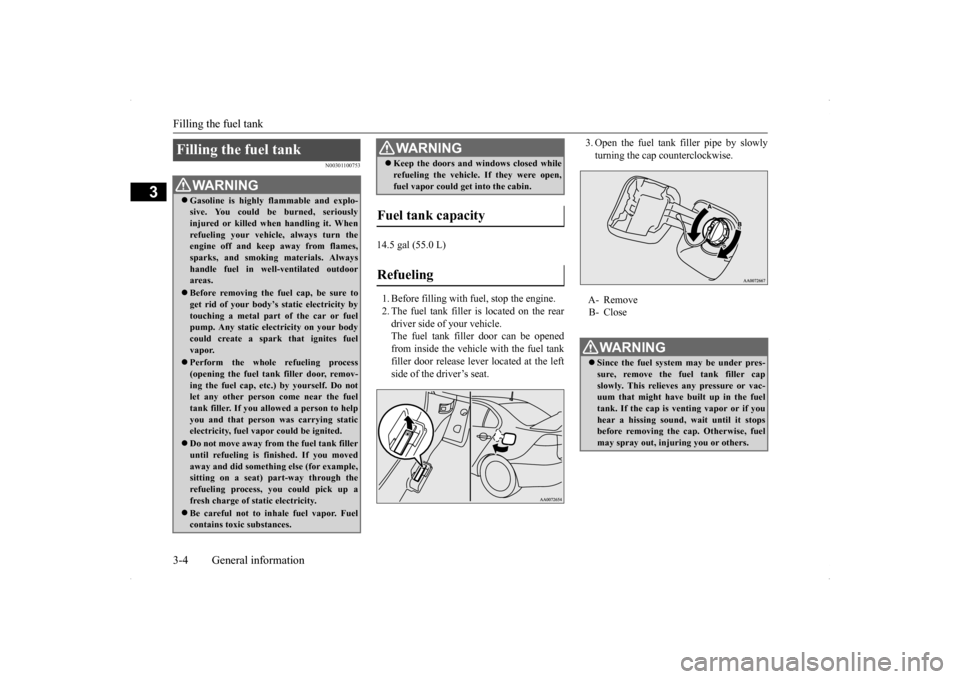
Filling the fuel tank 3-4 General information
3
N00301100753
14.5 gal (55.0 L) 1. Before filling with fuel, stop the engine. 2. The fuel tank filler is located on the reardriver side of your vehicle. The fuel tank filler door can be opened from inside the vehicle with the fuel tankfiller door release lever located at the left side of the driver’s seat.
3. Open the fuel tank filler pipe by slowly turning the cap counterclockwise.
Filling the fuel tank
WA R N I N G Gasoline is highly flammable and explo- sive. You could be burned, seriously injured or killed when handling it. When refueling your vehicle, always turn theengine off and keep away from flames, sparks, and smoking materials. Always handle fuel in well-ventilated outdoorareas. Before removing the fuel cap, be sure to get rid of your body’s static electricity by touching a metal part of the car or fuel pump. Any static electricity on your bodycould create a spark that ignites fuel vapor. Perform the whole refueling process (opening the fuel tank filler door, remov- ing the fuel cap, etc.) by yourself. Do notlet any other person come near the fuel tank filler. If you allowed a person to help you and that person was carrying staticelectricity, fuel vapor could be ignited. Do not move away from the fuel tank filler until refueling is finished. If you moved away and did something else (for example, sitting on a seat) part-way through the refueling process, you could pick up a fresh charge of static electricity. Be careful not to inhale fuel vapor. Fuel contains toxic substances.
Keep the doors and windows closed while refueling the vehicle. If they were open, fuel vapor could get into the cabin.
Fuel tank capacity Refueling
WA R N I N G
�ç
A- Remove B- Close WA R N I N G Since the fuel system may be under pres- sure, remove the fuel tank filler capslowly. This relieves any pressure or vac- uum that might have built up in the fuel tank. If the cap is venting vapor or if youhear a hissing sound, wait until it stops before removing the cap. Otherwise, fuel may spray out, injuring you or others.
�ç
BK0200800US.bo
ok 4 ページ 2013年2月14日 木曜日 午後2時28分
Page 22 of 338
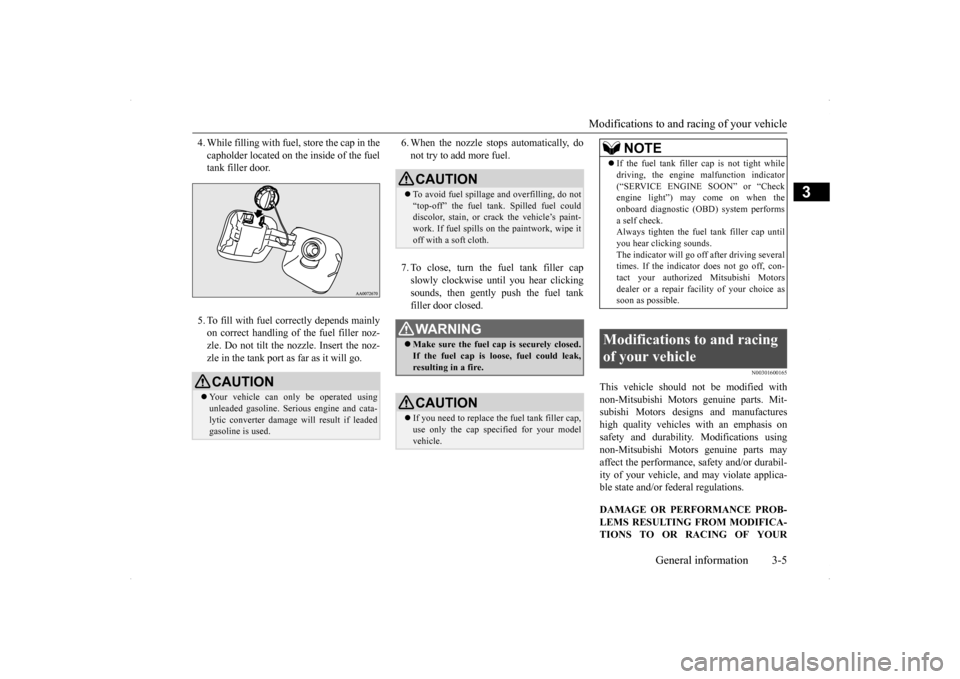
Modifications to and racing of your vehicle
General information 3-5
3
4. While filling with fuel, store the cap in the capholder located on the inside of the fuel tank filler door. 5. To fill with fuel correctly depends mainly on correct handling of the fuel filler noz- zle. Do not tilt the nozzle. Insert the noz-zle in the tank port as far as it will go.
6. When the nozzle stops automatically, do not try to add more fuel. 7. To close, turn the fuel tank filler cap slowly clockwise until you hear clickingsounds, then gently push the fuel tank filler door closed.
N00301600165
This vehicle should not be modified withnon-Mitsubishi Motors genuine parts. Mit- subishi Motors designs and manufactureshigh quality vehicles
with an emphasis on
safety and durability. Modifications using non-Mitsubishi Motors genuine parts mayaffect the performance, safety and/or durabil- ity of your vehicle, and may violate applica- ble state and/or federal regulations. DAMAGE OR PERFORMANCE PROB- LEMS RESULTING FROM MODIFICA- TIONS TO OR RACING OF YOUR
CAUTION Your vehicle can only be operated using unleaded gasoline. Serious engine and cata-lytic converter damage will result if leaded gasoline is used.
�ç
CAUTION To avoid fuel spillage and overfilling, do not “top-off” the fuel tank. Spilled fuel coulddiscolor, stain, or crack the vehicle’s paint- work. If fuel spills on the paintwork, wipe it off with a soft cloth.WA R N I N G Make sure the fuel cap is securely closed. If the fuel cap is loose, fuel could leak, resulting in a fire.CAUTION If you need to replace the fuel tank filler cap, use only the cap specified for your model vehicle.
NOTE
If the fuel tank filler
cap is not tight while
driving, the engine malfunction indicator (“SERVICE ENGINE SOON” or “Check engine light”) may come on when the onboard diagnostic (OBD) system performsa self check. Always tighten the fuel tank filler cap until you hear clicking sounds.The indicator will go off after driving several times. If the indicator does not go off, con- tact your authorized Mitsubishi Motorsdealer or a repair facility of your choice as soon as possible.
Modifications to and racing of your vehicle
BK0200800US.bo
ok 5 ページ 2013年2月14日 木曜日 午後2時28分
Page 27 of 338
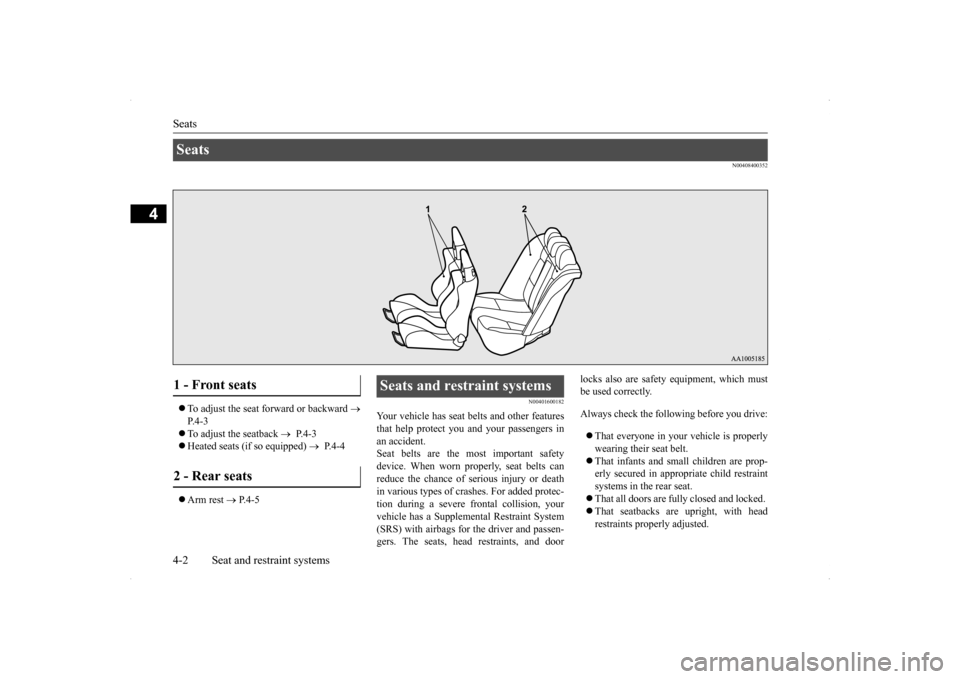
Seats 4-2 Seat and restraint systems
4
N00408400352
To adjust the seat forward or backward
P.4-3 To adjust the seatback
P.4-3
Heated seats (if so equipped)
P.4-4
Arm rest
P.4-5
N00401600182
Your vehicle has seat belts and other features that help protect you and your passengers inan accident. Seat belts are the most important safety device. When worn properly, seat belts canreduce the chance of serious injury or death in various types of crashes. For added protec- tion during a severe frontal collision, yourvehicle has a Supplemental Restraint System(SRS) with airbags for the driver and passen- gers. The seats, head restraints, and door
locks also are safety equipment, which must be used correctly. Always check the following before you drive: That everyone in your vehicle is properly wearing their seat belt. That infants and small children are prop- erly secured in appropriate child restraint systems in the rear seat. That all doors are full
y closed and locked.
That seatbacks are upright, with head restraints properly adjusted.
Seats 1 - Front seats 2 - Rear seats
Seats and restraint systems
BK0200800US.bo
ok 2 ページ 2013年2月14日 木曜日 午後2時28分
Page 28 of 338
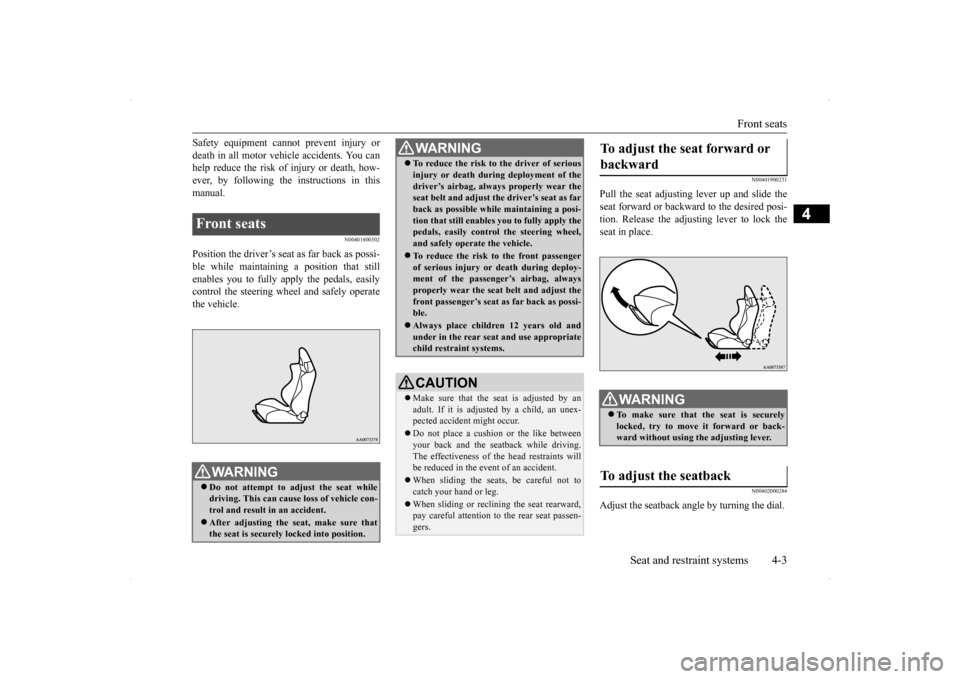
Front seats
Seat and restraint systems 4-3
4
Safety equipment cannot prevent injury or death in all motor vehicle accidents. You can help reduce the risk of injury or death, how- ever, by following the
instructions in this
manual.
N00401800302
Position the driver’s seat
as far back as possi-
ble while maintaining a position that stillenables you to fully apply the pedals, easily control the steering wheel and safely operate the vehicle.
N00401900231
Pull the seat adjusting lever up and slide theseat forward or backward to the desired posi- tion. Release the adjusting lever to lock the seat in place.
N00402000284
Adjust the seatback angle by turning the dial.
Front seats
WA R N I N G Do not attempt to adjust the seat while driving. This can cause loss of vehicle con- trol and result in an accident. After adjusting the seat, make sure that the seat is securely locked into position.
�ç
To reduce the risk to the driver of serious injury or death during deployment of the driver’s airbag, always properly wear the seat belt and adjust th
e driver’s seat as far
back as possible while maintaining a posi-tion that still enables
you to fully apply the
pedals, easily control the steering wheel, and safely operate the vehicle. To reduce the risk to the front passenger of serious injury or death during deploy-ment of the passenger’s airbag, always properly wear the seat belt and adjust the front passenger’s seat as far back as possi-ble. Always place children 12 years old and under in the rear seat and use appropriate child restraint systems.CAUTION Make sure that the seat is adjusted by an adult. If it is adjusted by a child, an unex-pected accident might occur. Do not place a cushion or the like between your back and the seatback while driving. The effectiveness of the head restraints will be reduced in the event of an accident. When sliding the seats, be careful not to catch your hand or leg. When sliding or reclining the seat rearward, pay careful attention to the rear seat passen- gers.WA R N I N G
To adjust the seat forward or backward
WA R N I N G To make sure that the seat is securely locked, try to move it forward or back- ward without using the adjusting lever.
To adjust the seatback �ç
BK0200800US.bo
ok 3 ページ 2013年2月14日 木曜日 午後2時28分
Page 31 of 338
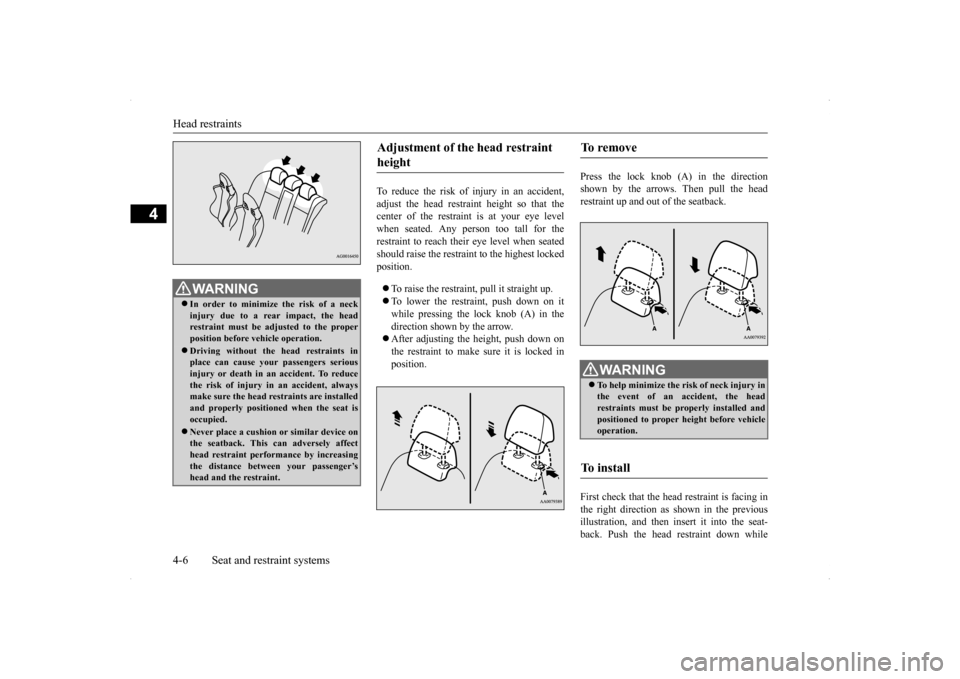
Head restraints 4-6 Seat and restraint systems
4
To reduce the risk of injury in an accident, adjust the head restraint height so that the center of the restraint is at your eye levelwhen seated. Any person too tall for the restraint to reach their eye level when seated should raise the restraint to the highest lockedposition. To raise the restraint, pull it straight up. To lower the restraint, push down on it while pressing the lock knob (A) in the direction shown by the arrow. After adjusting the height, push down on the restraint to make sure it is locked in position.
Press the lock knob (A) in the direction shown by the arrows. Then pull the headrestraint up and out of the seatback. First check that the head restraint is facing in the right direction as shown in the previousillustration, and then insert it into the seat- back. Push the head restraint down while
WA R N I N G In order to minimize the risk of a neck injury due to a rear impact, the head restraint must be adjusted to the properposition before vehicle operation. Driving without the head restraints in place can cause your passengers serious injury or death in an accident. To reduce the risk of injury in an accident, alwaysmake sure the head restraints are installed and properly positioned when the seat is occupied. Never place a cushion or similar device on the seatback. This can adversely affecthead restraint performance by increasing the distance between your passenger’s head and the restraint.
Adjustment of the head restraint height
To remove
WA R N I N G To help minimize the risk of neck injury in the event of an accident, the head restraints must be properly installed and positioned to proper height before vehicleoperation.
To i n s t a l l
BK0200800US.bo
ok 6 ページ 2013年2月14日 木曜日 午後2時28分